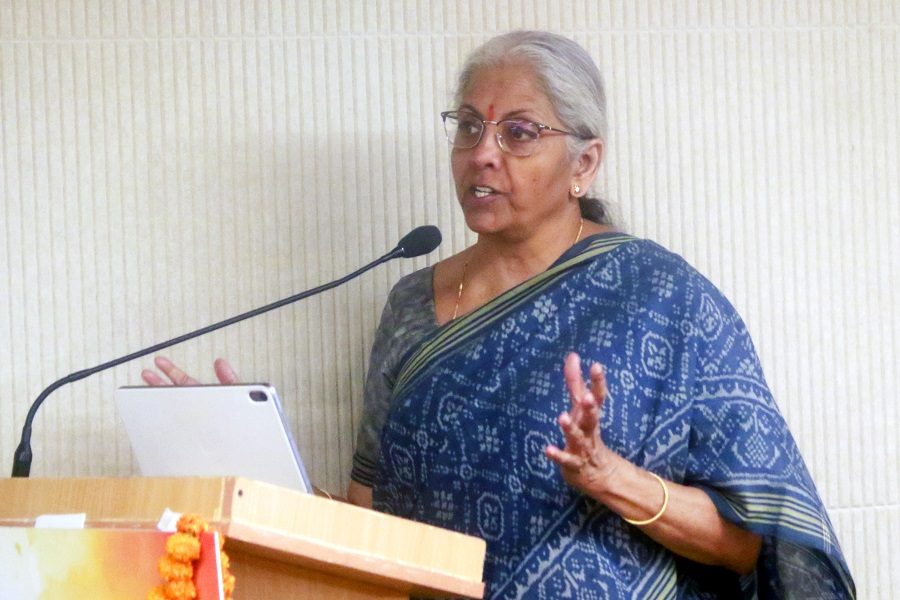SBICAPS Report - EcoCapsule- From K-Shaped Recovery To K-Shaped Narratives

EXECUTIVE SUMMARY (1/2)
* Jul’24 was data dense month for the global markets, with the changing colour of economic prints bringing the world to an inflection point. This led to a rapid realignment of rate cut expectations, and a global market sell-off ensued. Charting the chronology of the events reveals that the trigger point may have been the quickly souring after US non-farm payrolls clocking just a 114k increase (expected 175k) in Jul’24 and seeing downward revision for the previous month. This led to heightened recession fears, precipitating an equity sell-off and a rally in US Treasuries, with the market swiftly recalibrating its rate cut expectations for CY24 to 100-125 bps, up from the earlier 50-75 bps. This means that the probability for a Sep’24 rate cut is higher than before, and Jul’24 may have been the last hold
* Differential dynamics ensured that global Central Banks have refracted these events in divergent ways. For instance, the BoJ made a historic move to raise rates to ~25 bps and reduce bond purchases, aimed at curbing currency devaluation and controlling inflation. While this led to a worst bloodbath in the Nikkei since the 1980s, the JPY finally got a helping hand (vs. USD) after several months. Meanwhile, PBoC and BoE, to revitalize the economy, implemented cuts. China also added temporary repos and adjusted currency to avoid an unsustainable bond rally. The multi-faceted and unique strategies taken by global Central Banks reflects the ongoing priorities at hand – including growth, inflation, and currency
* Amid global turbulence which saw some correction in equity markets and the INR reaching a nadir vs. the USD, India continues to serve as an engine of global growth. Domestic high-frequency indicators showed sustained momentum. PMIs are firmly in the expansionary zone, with manufacturing performing exceptionally well. Manufacturing capacity utilization reached ~77% in Q4FY24, the highest in 11 years, while steel consumption maintained double-digit growth at 14.6% y/y in Jul’24. Agricultural recovery is expected to also gain traction, supported by above-normal monsoons (6.6% above LTA as of 11 Aug’24). This will support rural consumption, as evidenced by a 17.2% y/y increase in 2W sales in Jul’24. Driven by manufacturing and rural elation, we anticipate real GDP to grow by 7.0% y/y in FY25 – with downside risks primarily from global headwinds. Currency will be balanced by record forex buffers and CAD is in control
* Resilient domestic growth is reflected in buoyant receipts estimated in the Union Budget. Tax revenues are set to grow handsomely, with stellar gains in income taxes, while non-tax revenues are buoyed by expected traction in asset monetisation and shapely profits of PSUs. This enabled the Union to shave off a further 20bps from FY25BE (Interim) fiscal deficit estimate to reach 4.9% of GDP as per FY25BE, even though there is a marginal rise in revenue expenditure estimates and capital expenditure remains jubilant.
* Sunny growth expectations met with prickly inflation meant that the RBI maintained status quo on policy. Current volatility in TOP and pulses prices continue to challenge the MPC, keeping the headline CPI above target at 5.1% y/y in Jun’24. At the same time, the currently above-normal monsoon and sowing, backed up by a potential La Nina event later, promise reprieve in later quarters. Consequently, CPI projections of the MPC witnessed sharp upward front-ended revisions offset by moderation in later quarters. Led by food volatility, we continue expect the CPI to average 4.7% in FY25 (20 bps above RBI projection)
EXECUTIVE SUMMARY (2/2
The RBI, as well as SEBI and other stakeholders also continued their efforts to develop regulation to preserve financial stability. These include:
1. RBI’s draft proposal on adjusting LCR computations, aimed at increasing run-off rates for deposits by 5pp while mandating the fair valuation of Level 1 HQLA, in light of rising digital transactions. We anticipate impact of 10-17 pp on LCR across banking sector, with banks remaining at cushy LCR levels of ~130%
2. Adjustments to FAR list by RBI were also made, with the removal of new 14 and 30-year bonds to prevent global flows induced volatility in bond markets
3. Change in valuation norms of AT-1 bonds for mutual funds by SEBI, with them now being valued at yield-to-call instead of 100-year life
4. Caution was also raised by multiple stakeholders against retail F&O activity, culminating in the rise in STT on such instruments in the Union Budget
Stubborn food prices, robust domestic growth, pressure on INR from actions of global Central Banks – all point towards the RBI maintaining rates higher for longer. This, coupled with a paper in the RBI’s Bulletin arguing that the neutral real rate has increased indicates that the first rate is now expected in late FY25. Nevertheless, 10Y benchmark Union G-sec yield is firmly lodged under 7%, driven by multi-month high liquidity and accelerated expectations of cuts in the US, rather than expectations of an immediate rate cut. It is expected to further reduce by 10-15 bps over the medium term driven by similar cues, helped further by Union fiscal consolidation, bond index inflows, and sustained demand for G-sec paper.
Above views are of the author and not of the website kindly read disclaimer
























